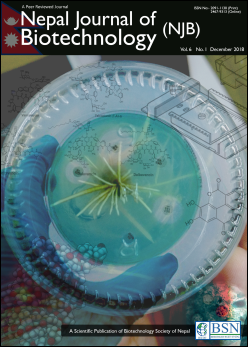Technologies for the Extraction, Separation and Purification of polyphenols – A Review
DOI:
https://doi.org/10.3126/njb.v6i1.22341Keywords:
Polyphenols, Conventional extraction process, Emerging technologiesAbstract
Polyphenols are high molecular weight, organic molecules mainly found in plant kingdom. They are mostly known for their positive impact on health, specifically for their antioxidant activity. Indeed, they are widely studied for the prevention of multiple diseases such as cancer, inflammatory, cardiovascular and neurodegenerative diseases. Nevertheless, extractions of these growing interest molecules remain challenging using conventional methods such as solvent extraction. That is why recent researches have focused on improving the extraction of polyphenol by using different technologies such as ultrasound, microwave, pressurized liquid, pulsed electric field, supercritical fluid and high hydrostatic pressure. In the current context, the assisted-extraction should demonstrate their potential to improve the extraction efficiency while being cost-effective and with a low environmental impact. To this end, technologies ought to, for instance, increase the solubility of polyphenol and the permeability of the cell wall. Consequently, this review is focused on the use and potential of these technologies to improve polyphenol extractions from plants as well as their purification using various methods. It discusses of the advantages and disadvantages with some examples of all these technologies assisted-extraction in comparison with conventional extraction method as well as purification technology.
Downloads
Downloads
Published
How to Cite
Issue
Section
License
Copyright Notice:
The manuscript submitted to NJB must be an original contribution, not previously published and should not be under consideration for publication elsewhere. When the manuscript is accepted for publication, the authors agree to automatically transfer the copyright of the article to the publisher. It should grant permission to any third party, in advance and in perpetuity, the right to use, reproduce or disseminate your article, according to the NJB copyright and license agreement.
Authors transfer copyright to the publisher as part of a journal publishing agreement but have the rights to: Share their article for Personal Use, Internal Institutional Use and Scholarly Sharing purposes, with the NJB applies the Creative Commons Attribution-NonCommercial CC BY-NC license to all the works we publish after Jun 2020 (Before it was CC BY-NC-ND). Under this license, authors agree to make articles legally available for reuse, without permission or fees, for virtually any non-commercial purpose. Anyone may remix, adapt, and build upon your work non-commercially, and although their new works must also acknowledge you and be non-commercial, they don’t have to license their derivative works on the same terms. More details on CC BY-NC refer to its Licence Deed and Legal Code.






